What about the weather?
Whatever the season, the emails and phone calls come flooding in (not literally, of course) asking about the suitability of the prevailing climatic conditions for paving and hard-landscaping works. In some cases, it's keen DIYers wondering whether they can crack on with that new patio if they shovel off the 300mm of snow that currently covers the site, while others are concerned that a contractor is screeding out a laying course in torrential rain.
So here's a concise guide to how the weather affects what can and can't be done.
The two biggest impediments to paving work are heavy rain and hard frost . Neither is particularly pleasant to work in, but there are sound structural reasons for not working when these conditions prevail. The other climatic concern is heat , those all-too-rare occasions when Britain and Ireland bask in unbroken sunshine. Much better for working, but hight temps still present a challenge to the paving trade.
Rain:
Showers and drizzle are a fact of life in Britain and Ireland. If we were to stop work every time a bit of precipitation descended, we'd never get anything done, and there's a good case to be made that we full-time residents of the soggy isles are actually genetically pre-disposed to function better in a chilly, damp climate. I know that my skin starts to crack and peel unless I'm rained on at least twice a week.
Most tasks can continue during light showers and drizzle with the obvious exception of detailed mortar work, such as pointing , and jointing of block paving with kiln-dried sand (although there is a workaround for this). So, excavation, drainage installation , stoning-up (spreading and levelling sub-base material), edges and kerbs , and even laying of paving and surfacing can continue more or less unimpeded.

Blacktop (tarmacadam) and asphalt can be laid during light precipitation, but should not be laid over areas of standing water. There's a good argument to be made that concrete is best laid in damp conditions, but there is a concern that the surface can be 'pitted' by heavier raindrops, so any high-end decorative concrete work, such as Pattern Imprinted Concrete , is best protected by covering.
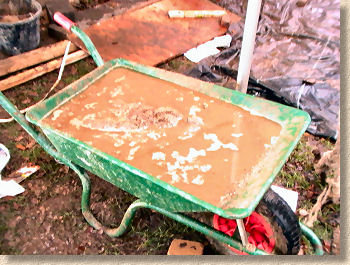
Flags, setts, cobbles, block paving and loose aggregates can be laid during damp weather as long as the laying course, whether it is a cementitious material ( mortar or concrete ) or an unbound aggregate (sand, grit, whin dust) is not overly wet.
Excessive water will weaken mortars and concretes, so stiffer mixes (lower slump) may be used during light rain or drizzle to accommodate the extra moisture provided by the environment.
For unbound laying courses, the usual rule of thumb is that the bed or screed should not be saturated or hold excess water. If a handful of the sand was grabbed and squeezed in the hand, very little or no water should dribble out. If the sand (or grit or whin) is holding water, it is likely to 'fluidise' when a paving unit is laid onto it or when it is compacted, and instead of providing a firm bed, it acts more like a blancmange, shifting and settling in an unpredictable manner.
Resin based aggregates can usually be laid over damp surfaces without hindrance, but this should be checked as some resins are more susceptible to water than others. As with blacktop, laying over areas of standing water is never a good idea.
Heavy rain
is more of a problem. It makes for unpleasant working conditions, but it can also cause havoc with many forms of paving and surfacing.
As mentioned above, for most forms of modular paving (flags, blocks, setts, kerbs, etc.) heavy rain can saturate the bed, leading to fluidisation and/or over-wetting of mortars and concrete.
Many of the more familiar methods of jointing are impractical in heavy rain, but some are actually easier: slurry grouts of both cementitious and resin mortars are likely to be unaffected by all but the most torrential of downpours.
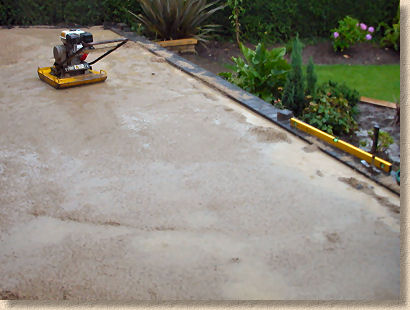
Pattern Imprinted Concrete relies on a precise decorative surface and so should not be installed when there is heavy or prolonged rain, and serious consideration should be given to whether laying plain concrete surfaces will be adversely affected by heavy raindrops or excessive surface water.
Frost:
The two biggest problems with frost are that it interferes with the curing of cementitious materials and that it causes temporary expansion or swelling of unbound materials. If a frozen sub-grade was paved over, or even if a frozen aggregate was laid, compacted and then paved, once the frost comes, the whole lot will sink, as the sub-grade and/or aggregate shrinks back to its normal, thawed-out volume, taking all that paving with it.
Prolonged or hard frosts can put a stop to almost all construction work, with the exception of excavation and some drainage works.
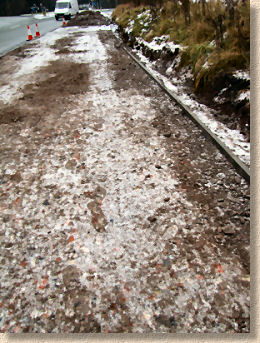
For mortars and concretes, the usual rule of thumb is that they should not be used unless the ambient temperature is 3°C and rising ( BS EN 998-2:2016 and IS EN 1996/SR 325). There are frostproofers that can be added to mixes, and pre-batched frost-proof mortars and repair concretes available for when work simply has to go on, but it should come as no surprise to learn that they are somewhat more expensive than standard mortars.
It's important to acknowledge that when mixing mortar or concrete on site during frosty periods, any frozen sand, gravel or other aggregate should be excluded from the mix. It's not uncommon to find a frozen crust on sand: while the unfrozen sand beneath the crust could be used to prepare a mortar or concrete, the crust itself should be set aside to await the thaw.
Under normal circumstances, installation of modular paving onto mortar or concrete beds is suspended until the frost lifts. Kerb-laying often continues in light frosts, although the kerbs would be bedded onto a frost-proofed concrete.
Similarly, frost-proofed concrete may be laid as a surfacing but additional protection from air-frosts is usually required in the form of an insulated or heated covering. For residential installations of PIC, work is normally suspended as the cost of providing a heated cover is often beyond the value of the work.
Hot-laid asphalt and macadam laying often continues in temperatures down to around 4°C, the one notable exception being base or binder courses laid directly onto a frozen sub-base, which is not acceptable (see below).
Resin-based surfacing, in theory, could continue in sub-zero conditions, as the resins are not directly impaired by low temps, but many will take considerably longer to harden, and some manufacturers provide special 'winter' versions of their resins especially for use during the chillier months.
Similarly, resin-based mortar for jointing are largely unaffected by mild frosts, but curing will be slowed and consideration should be given to the effect of a frost on the paving medium itself: flags laid on sand may be shunted out of level by a hard frost and therefore jointing while they are in that condition is not advisable.
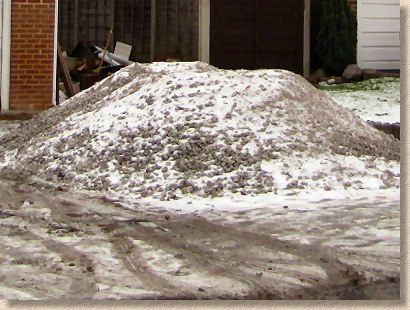
There's a common misconception that work with aggregates can continue during a frost, but as hinted at previously, frozen materials are often swollen by the presence of frost, and so their use gives incorrect levels and partial compaction. Consequently, work such as stoning-up is often suspended, and even simple tasks such as creating a screeded laying course are stopped because of the problem of frozen sub-bases or sub-grades having risen (frost heave) and so presenting incorrect working levels.
Further, an unbound laying course (sand, etc.) is likely to freeze solid, due to its shallow depth, rendering compaction impossible.
In short, when the temp doesn't rise above freezing, it's best to suspend work if at all possible.
Heat:
This may come as a bit of a surprise to some readers. While heavy rain and frost could be predicted to adversely affect construction work, the effects of extended periods of hot, dry weather are less obvious.
On the few days we do get "Scorchio" conditions, the most noticeable impact is on (surprise, surprise) mortars and concretes. The elevated temperatures and arid atmosphere can parch mixes, driving off the moisture that is essential for proper hydration of the cement content.
Concrete surfaces, both plain and decorative, often need to be protected from direct sunlight to maintain a humidity level that will minimise cracking of the surface that occurs as the curing process is accelerated by the higher-than-normal temperatures and the mix water is evaporated off. Polythene sheets or even fine-misting systems are often used to protect concrete on the hottest of days.
Modular paving laid onto cementitious beds can also suffer as the mix starts to stiffen that much more quickly in the elevated temperatures. Porous paving materials, such as wet-cast flags and some types of natural stone, can themselves become parched and so wick moisture out of the bed, which can cause problems for bed strength and, less obviously, with discolouring of susceptible paving units (some of the imported granites are particularly prone to this problem).
This parching problem can be worryingly troublesome when it comes to jointing. Parched flags or setts will literally suck out the moisture from a cement mortar, drastically reducing the water/cement ratio and drying out the mix before the cement has had a chance to hydrate, resulting in a crumbly, friable mortar that falls apart when brushed or scoured. An old flagger's trick to help counter this problem is to soak the flags/setts with water the night before, so their thirst is slaked but their surface relatively dry by the time they come to be laid the following day.
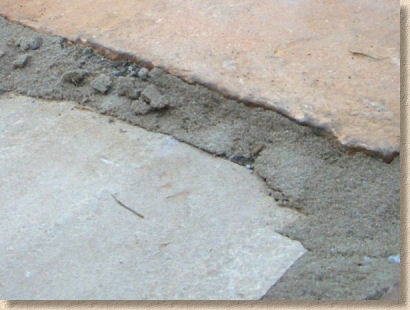
Asphalt and macadams will take longer to harden on hot days, as the heat helps the solvents keep the binder fluid for longer, and so it may be necessary to keep a freshly-laid surface traffic-free overnight so that the blacktop has a chance to thoroughly cool.
Resins tend to harden faster at higher temperatures, and so working time can be dramatically reduced. Some resin systems allow the quantity of the hardener component to be reduced to compensate for the accelerated setting during warmer periods, but experienced practitioners will usually adjust their working practices to suit the weather, mixing smaller batches to ensure they can be spread, levelled and compacted before they start to stiffen.
A less well-known problem with warmer weather is the drying of laying course aggregates. Research has shown that optimal compaction is achieved when a laying course aggregate has some moisture present. A simple thought experiment should make this clear: what happens when a bone-dry laying course is subjected to the plate compactor? Most contractors will acknowledge that the sand tends to be spewed out from beneath the plate as a fine dust-like cloud, and the result is the bed is not actually compacted.
The optimal moisture content for laying course material is usually somewhere around 8-13%. The sand (or grit, whin, etc.) needs to be vaguely damp, but not wet. The usually rough guide is that, when squeezed in the hand, the sand should just about clump together. If it filters through the fingers, it's too dry, and if any water runs out, it's too wet.
Although rarely seen, laying course material should be covered with a tarpaulin of other protective sheet during hot weather to keep in that essential moisture. As with the tip about soaking flags the night before laying, mounds of sand (or bulk bags) should be hosed down during a heatwave and allowed to drain under gravity.
